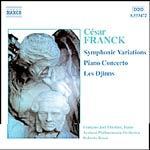
Franck: Symphonic Variations / Les Djinns / Piano Concerto No 2
 $25.00
Out of Stock
$25.00
Out of Stock6+ weeks add to cart
CESAR FRANCK
Franck: Symphonic Variations / Les Djinns / Piano Concerto No 2
Francois-Joel Thiollier & Martjn van den Hoek (pianos) / Arnhem PO / Roberto Benz
[ Naxos / CD ]
Release Date: Sunday 3 February 2002
This item is currently out of stock. It may take 6 or more weeks to obtain from when you place your order as this is a specialist product.
Not so well known repertoire of Cesar Franck
"Anyone who did not know that Cesar Franck wrote one piano concerto, let alone two, is excused; both are precociously early works, and the second, in B minor, probably dates from 1835 when he was just 13, and a budding piano virtuoso..it makes sense to include it here as the rarity alongside Franck's Symphonic Variations for piano and orchestra, a piece that seems far less popular now in the concert hall and on CD than it was in the LP era. It is also accompanied by the Victor Hugo-inspired symphonic poem Les Djinns, from 1884, which has a substantial role for the solo piano."
- The Guardian (London), February 1, 2002
Belgian by birth, French by choice and of more remote possible German ancestry, César Franck was born in 1822 in the Walloon city of Liège. His musical gifts, obvious at an early age, were encouraged by his father, who saw the possibility of a career for his son as a virtuoso performer. Study at the Conservatoire in Liège and early concert performance, with compositions to match his father's ambitions, was followed by a period of respite from concert activity in Paris, with lessons from Antonín Reicha in the techniques of composition and rigorous piano discipline from Pierre-Joseph-Guillaume Zimmermann. In 1837 he was admitted to the Paris Conservatoire, where he began to win some distinction, continuing his piano lessons with Zimmermann and studying the organ rather less effectively under François Benoist. The natural course for Franck would have been to enter for the important Prix de Rome, victory in which would have brought three years study in Rome. It was, however, in 1842, when such a triumph seemed to lie before him, that his father withdrew him from the Conservatoire, now seeking for his son once more a career as a performer, initially in Belgium again, where it was hoped to interest influential patrons. Two years later the Francks were back in Paris again.
Franck's failure to impress, either as a pianist or as a composer, brought in the following years the need to earn a living as a teacher. His marriage in 1848 to one of his pupils, Blanche Saillot Desmousseaux, the daughter of parents of importance in the Comédie Française, heirs to a long family theatrical tradition, brought a breach with his father. From now on he continued to earn a living by teaching and as an organist, at first at Notre-Dame-de-Lorette, where he had been married. In 1851 he moved to Saint-Jean-Saint-François-au-Marais, with its fine new Cavaillé-Coll organ and in 1858 he was appointed organist at Sainte-Clotilde, where Cavaillé-Coll installed a new instrument, generally regarded as the finest example of its kind. It was at Sainte-Clotilde over the following years that Franck built a reputation as an organist. In 1872, after a period in which he had won the loyalty and affection of a group of pupils, led by Duparc, and during which his music had been performed under the auspices of the Société Nationale de Musique, a body devoted to the promotion of Ars Gallica, he was appointed to the position of professor of organ at the Conservatoire.
From the 1870s onwards Franck devoted himself to composition, influenced in particular by hearing, in 1874, Wagner's Tristan und Isolde, which made a profound impression on him. At the Conservatoire he aroused some jealousy in his colleagues by attracting to his classes a group of young composers, among them Vincent d'Indy, one of the most devoted of the group known as the bande à Franck, to whom their teacher was known as Pater Seraphicus.
It was largely through d'Indy that Franck, in 1886, succeeded Saint-Saëns as president of the Société Nationale, after resignations from the committee over the admittance of foreign music. As a composer Franck enjoyed limited contemporary success and a concert of his works, given in 1887, was an under-rehearsed disaster during which even the Symphonic Variations barely held together. The decade before Franck's death in 1890, however, brought a series of works that have long been part of continuing concert repertoire, above all the Violin Sonata, the single Symphony and the Symphonic Variations.
Tracks:
Symphonic Variations
01. Symphonic Variations 14:53
Francois-Joel Thiollier, piano
Les Djinns
02. Les Djinns 12:06
Francois-Joel Thiollier, piano
Piano Concerto No. 2 in B minor, Op. 11
03. Allegro maestoso 15:36
04. Adagio 06:46
05. Rondo: Allegro 09:38
Martijn van den Hoek, piano